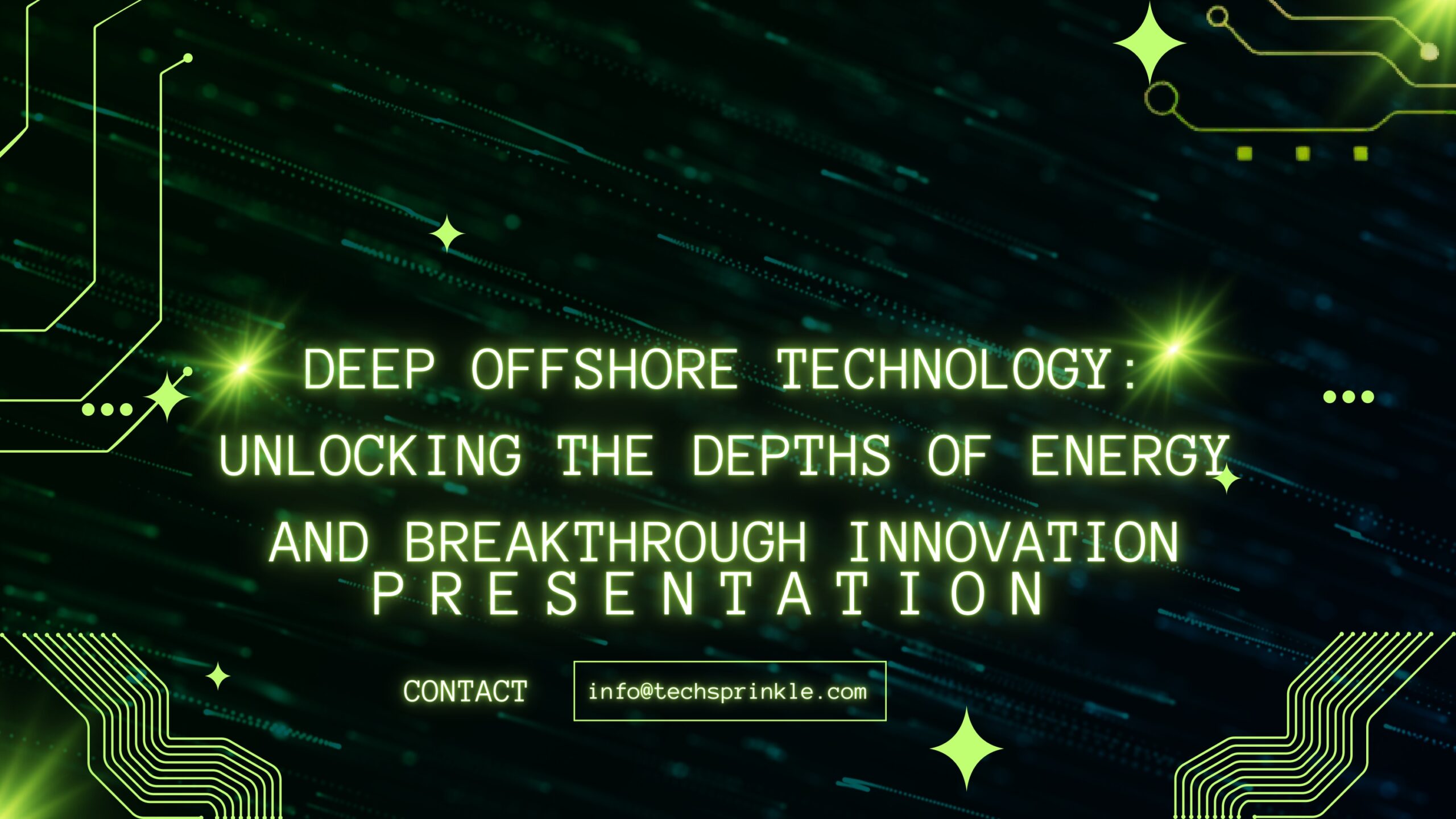Table of Contents
Introduction
The water has long been a place of peril mystery and possibility. In the current period, it has also become an important area for technical progress especially in the form of deep offshore technology. As the world’s energy needs grow and resources close to shore run out, the attention has moved to deep offshore areas which are more than 500 meters below sea level. These areas are being explored and produced for important resources including oil gas and renewable energy.
But getting to these faraway and harsh places isn’t easy. It needs advanced engineering robotics remote systems and making decisions based on data. Deep offshore technology isn’t only about drilling deeper; it’s also about living and flourishing in one of the most difficult places on Earth.
This blog will talk about what deep offshore technology is, why it matters how it works its pros and cons, the most important things to think about while using it and what the future holds for this important sector.
What is the meaning of deep offshore technology?
Deep offshore technology is the set of advanced equipment systems and processes used to find, extract, and manage resources in deep-water marine settings. These include work done at depths of more than 500 meters (1,640 feet) and in many cases much than 3,000 meters (9,800 ft).
This technology includes:
Floating production platforms (FPSOs and TLPs)
Vehicles that can be controlled from a distance (ROVs)
Autonomous, Underwater Vehicles (AUVs)
More advanced sensors and monitoring systems
High pressure and high-temperature (HPHT) tools
Systems for dynamic positioning
Umbilicals and subsea pipelines
The oil and gas business is the main one that does deep offshore work although deep-sea mining carbon capture and storage (CCS) and offshore wind or tidal energy systems also do it.
Why is it important to have deep offshore technology?
Deep offshore technology fields are one of the few places where large-scale energy discovery and production may happen since onshore and shallow water energy deposits are getting difficult to locate or more expensive to get there.
Here are some important reasons why deep offshore technology is necessary:
1. Resource Potential
There are a lot of unexplored oil gas and mineral deposits, in deepwater areas. The International Energy Agency (IEA) says that deepwater oil production might account for more than 10% of the world’s supply in the near future.
2. Energy Security Countries
who don’t have a lot of resources, on land can become more energy independent by investing in offshore technology.
3. Progress in technology
Building and using these technologies pushes the limits of science and engineering which leads to more innovation.
4. Keeping an eye on the environment
Scientists can also learn more about deep marine ecosystems and keep an eye on how people affect them with the assistance of advanced subsea sensors and robotics.
5. Help for renewable energy
A lot of the technology that was made for oil and gas is now being used for offshore wind and other renewable energy sources, that come from the ocean.
How does technology work deep in the ocean?
To work in deep offshore technology conditions a number of systems that depend on one other must work together. This is a simple explanation of how the technology works:
1. Surveying and exploring
Companies use geological surveys with seismic imaging sonar and AUVs to find regions that could have a lot of resources before they drill or install anything.
2. Drilling Underwater
Deepwater drilling rigs or ships, use blowout preventers and HPHT technology to regulate severe pressures as they drill into the seabed.
3. Platforms that float
Fixed platforms won’t work because of the depth. Floating platforms like FPSOs (Floating Production Storage and Offloading units) or Tension Leg Platforms (TLPs) are anchored to the seabed instead.
4. Systems for Production Underwater
On the seabed wellheads manifolds and pipelines are put in place to gather and move items that have been taken out to the platform or shore.
5. Operations from a distance
ROVs or AUVs provide maintenance and inspections since they can’t get to the site. These vehicles may work on their own or be controlled from the surface.
6. Keeping an eye on things and controlling them
Operators keep an eye on the health of their equipment pressure flow rates and environmental variables using real time data from sensors and AI driven platforms.
Benefits of Deep Offshore Technology
1. Access to a lot of resources
Deep offshore technology fields, usually have more reserves than onshore resources which means they can keep supplying oil for a long time.
2. Energy Independence
Countries might depend less on imports by building up their own offshore capabilities.
3. New technology
This field leads to the creation of novel materials, robots, and software systems that can be used for more than only energy.
4. Less Impact on Land
Offshore installations are far away from people, therefore they don’t directly affect communities as much as onshore drilling does.
5. Making jobs
Big projects create work in a lot of different fields, including engineering, marine, environmental, and data science.
The worst things of deep offshore technology
1. High Price
Exploration, development and upkeep are very costly and can need billions of dollars in investment.
2. Risk to the environment
Accidents like oil leaks like the Deepwater Horizon may have terrible effects on marine ecosystems, that linger for a long time.
3. How complicated it is technically
When working in very high pressure, temperature, and corrosion conditions, you need unique systems that are typically quite delicate.
4. Problems with rules
Projects have to follow tight environmental rules and standards in both the country and the world, which slows down deployment.
5. Hard to get to
In case of an emergency or a breakdown, it’s hard to get help quickly because the location is so far away and deep.
Important Things for Deep Offshore Success
There are a few important things that need to be done to make sure that deep offshore technology projects are successful and last:
1. How reliable the technology is
All systems need to be strong and tested to work for a long time in dangerous underwater settings.
2. Managing data in real time
For predictive, maintenance and risk reduction advanced monitoring systems, that use AI and the Internet of Things (IoT) are very important.
3. Protecting the environment
To maintain marine biodiversity there must be strict ecological evaluations and backup plans in place.
4. A skilled workforce
It is important to know a lot about subsea engineering, geology robotics and marine operations.
5. Money to back it up
Projects need good investment plans and generally work with the government or private companies since they cost a lot.
6. Following the rules
You must understand and follow the rules, set by groups like the EPA IMO or your local marine authority.
7. Ecosystem of Innovation
Working together, colleges, tech startups, and big companies may come up with new ideas and make big advances.
Uses Outside of Oil and Gas
Deep offshore technology has mostly been used for hydrocarbons in the past, but it is now being used in other fields as well:
Deep-Sea Mining Technologies are being changed to get minerals like cobalt, manganese, and rare earth elements from the ocean floor.
Wind Power from the Sea
Many of the same mooring and anchoring technologies, that oil rigs employ are also used by floating wind turbines.
Marine Research: Scientists use ROVs and AUVs with sensors to investigate ecosystems that haven’t been discovered before and keep an eye on signs of climate change.
Carbon Capture and Storage (CCS) is a method that uses empty deepwater oil fields to safely store carbon dioxide that has been captured.
Conclusion
Deep offshore technology is an amazing mix of human creativity, cutting-edge science, and big dreams. It lets us use the deep sea’s huge potential for things like energy minerals or understanding the ecosystem even if it is quite hard to do so. The risks and expenses are significant but the benefits may change economies industries, and the way technology works.
But for these projects to work they need to be well planned take care of the environment keep coming up with new ideas and work together with other countries. Deep offshore technology can assist fulfill the world’s expanding needs while also setting the framework for a future that is both technologically sophisticated and environmentally friendly.









